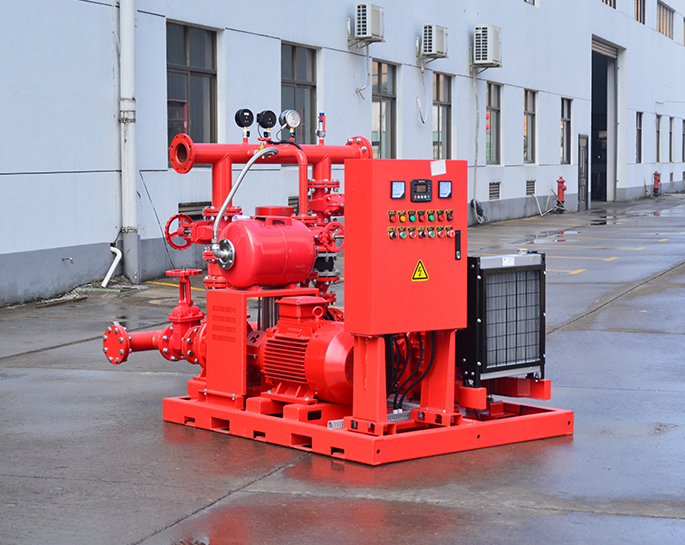What are the primary components of a firefighting pump system?
Apr 23, 2024
Share:
A firefighting pump system consists of several essential components that work together to provide water flow and pressure for extinguishing fires. The primary components include:
1. **Pump**: The pump is the core component of the system responsible for creating water flow and pressure. It draws water from a water source (such as a hydrant, tank, or open water source) and delivers it to the firefighting equipment, such as hoses or nozzles. Firefighting pumps can be centrifugal, positive displacement, or piston-driven, depending on the application.
2. **Engine or Motor**: The engine or motor provides the power necessary to drive the pump. It can be diesel, gasoline, electric, or hydraulic-powered, depending on the specific requirements of the firefighting operation. The engine or motor may be integrated with the pump in portable units or connected via a power take-off (PTO) system in vehicle-mounted pumps.
3. **Water Source**: A reliable water source is essential for firefighting pump systems. This can include municipal water supplies, hydrants, water tanks, natural bodies of water (lakes, rivers, etc.), or dedicated water reservoirs. Access to an adequate water source is critical for ensuring the effectiveness of the firefighting operation.
4. **Suction Hose**: The suction hose is used to draw water from the water source into the pump. It is typically connected to the inlet of the pump and may include strainers or filters to prevent debris from entering the pump and causing damage.
5. **Discharge Hose**: The discharge hose carries pressurized water from the pump to the firefighting equipment, such as hoses, nozzles, or monitors. It is essential for delivering water to the fire scene and can vary in size and length depending on the required flow rate and distance.
6. **Control Panel**: In modern firefighting pump systems, a control panel or interface allows operators to monitor and control various parameters, such as pump speed, water pressure, and engine/motor operation. It may include gauges, switches, valves, and other controls for managing the pump system efficiently.
7. **Frame or Mounting**: The pump, engine/motor, and other components are often mounted on a frame or platform for stability and portability. In portable units, this frame may include handles, wheels, or towing attachments for ease of transport.
These components work together to form a functional firefighting pump system capable of delivering water to extinguish fires effectively and efficiently. Regular maintenance, testing, and training are essential to ensure the reliability and performance of the system during emergency situations.

1. **Pump**: The pump is the core component of the system responsible for creating water flow and pressure. It draws water from a water source (such as a hydrant, tank, or open water source) and delivers it to the firefighting equipment, such as hoses or nozzles. Firefighting pumps can be centrifugal, positive displacement, or piston-driven, depending on the application.
2. **Engine or Motor**: The engine or motor provides the power necessary to drive the pump. It can be diesel, gasoline, electric, or hydraulic-powered, depending on the specific requirements of the firefighting operation. The engine or motor may be integrated with the pump in portable units or connected via a power take-off (PTO) system in vehicle-mounted pumps.
3. **Water Source**: A reliable water source is essential for firefighting pump systems. This can include municipal water supplies, hydrants, water tanks, natural bodies of water (lakes, rivers, etc.), or dedicated water reservoirs. Access to an adequate water source is critical for ensuring the effectiveness of the firefighting operation.
4. **Suction Hose**: The suction hose is used to draw water from the water source into the pump. It is typically connected to the inlet of the pump and may include strainers or filters to prevent debris from entering the pump and causing damage.
5. **Discharge Hose**: The discharge hose carries pressurized water from the pump to the firefighting equipment, such as hoses, nozzles, or monitors. It is essential for delivering water to the fire scene and can vary in size and length depending on the required flow rate and distance.
6. **Control Panel**: In modern firefighting pump systems, a control panel or interface allows operators to monitor and control various parameters, such as pump speed, water pressure, and engine/motor operation. It may include gauges, switches, valves, and other controls for managing the pump system efficiently.
7. **Frame or Mounting**: The pump, engine/motor, and other components are often mounted on a frame or platform for stability and portability. In portable units, this frame may include handles, wheels, or towing attachments for ease of transport.
These components work together to form a functional firefighting pump system capable of delivering water to extinguish fires effectively and efficiently. Regular maintenance, testing, and training are essential to ensure the reliability and performance of the system during emergency situations.


.png)
.png)

.png)


